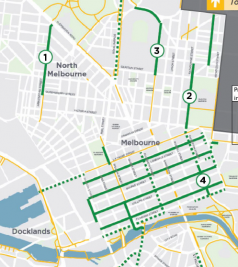Transport planners have been warning Government for decades. In a very fast growing metropolis we need to facilitate major shifts away from private vehicles to public transport and active transport modes, or suffer the alternative: intolerable congestion, pollution, socially inequitable transport pricing and less healthy communities.
Melbourne’s CBD is blessed with wide streets, thanks to Robert Hoddle convincing a reluctant Governor Bourke that Melbourne’s main streets should be one and a half chains (99ft) rather than the standard single chain (66ft) accepted as standard street width in most Australian cities and towns established in the 1800s.
Those main streets now carry tram passengers, pedestrians, cyclists and drivers, with private vehicles by far the least efficient mode in terms of surface area density. Nearly a million people visited the centre of Melbourne on any given weekday prior to the onset of the pandemic, and Council has long known that the solution to moving the greatest number of people about the city as efficiently as possible must include transferring private vehicle lanes to footpaths and cycling infrastructure, while ensuring that everybody is able to access every part of the city regardless of their access needs.
But we also have a highly fragmented governance framework when it comes to transport planning. VicRoads, now absorbed into the Department of Transport, controls all the traffic signals in the state as well as all State arterial roads, so any local road changes that require signalling changes or that change traffic flows onto State arterials – that’s just about all of them – need to be approved by the Department. Any projects deemed ‘significant’ may need Ministerial approval. The political hurdles to converting road space to facilitate more efficient transport modes are many.
Two major breakthroughs have occurred in the last four months. In February, before the pandemic hit, Council agreed its priorities for accelerated action to address the Climate Emergency, which was declared by Council in 2019 thanks to the work of Cr Oke. These priorities are bold among cities that have declared an emergency, and include fast-tracking the 44km of new physically separated bicycle lanes identified in the Transport Strategy 2030. That is, we agreed to construct 44km worth of new lanes in 4 years.
Then the pandemic changed the way we live, work and move. No one in Government is yet confident on what commuter patterns will look like once people return to work in the central city, what social-distancing on public transport actually looks like and whether the uptake in commuting by car will cause our road network to grind to a halt. We do know, though, that cycling is up in a big way: a Bicycle Network survey of 8,800 riders on 25 April showed the number of cyclists were up 270 per cent compared with November 2019, including a 221% increase on the Capital City Trail and a 303% increase on the Moonee Ponds Creek Trail. This data is already 8 weeks old, and Council’s own data has showed that cycling has increased further still despite the colder weather.
Now is the opportunity for major change, not the politically-palatable pace set by the State Government’s pre-pandemic approvals process. Our previous record annual spend on bicycle infrastructure was $5.1 million in 2012-13, when we built new lanes on Latrobe Street. In 2020-21 we have budgeted $16 million and are asking for more through Government stimulus infrastructure programs. This gets us well on the way to constructing 44km in 4 years.
Rathdowne Street and Exhibition Street are at the top of the list, to make safe a major north-south commuting corridor that links up with Canning Street into the Cities of Yarra and Moreland. The full length of Abbotsford Street in North Melbourne and the rest of Swanston Street North, north of Grattan Street, and the rest of William Street (south of Little Collins) will be completed as well. Whiteman and Queens Bridge will provide a new safe route through Southbank to the City of Port Phillip. We’ll also throttle traffic on the ‘little streets’ and make much of these streets shared zones with lower speed limits. Second round projects include, almost miraculously, Flinders Street! This announcement would have been unimaginable a year ago.
This is all in the context of a 2020-21 Council budget that will experience a $100m hit due to the pandemic; but the timing is urgent and the opportunity unprecedented, so we are delighted that councillors unanimously endorsed the draft budget in May with these projects included.
We are beyond proud of this work, and the work of our officers in a highly fragmented governance environment. There are still plenty of challenges, with some key routes like Peel Street still not over the line with Government approval, and the State is as recalcitrant as ever to build safe cycling infrastructure on State Arterial Roads like Flemington Road. But Council’s unprecedented contribution to the transport mode-shift revolution is the result not only of the opportunity that the COVID-19 crisis presents, but of years of determined policy work and persistence.
The climate emergency hasn’t stepped aside for the pandemic. This unprecedented expenditure on active transport is only a start, but it’s the start we need if we are serious about planning a sustainable city of the future. Let’s do this.

See detailed City of Melbourne map showing 40km of new bicycle lanes
